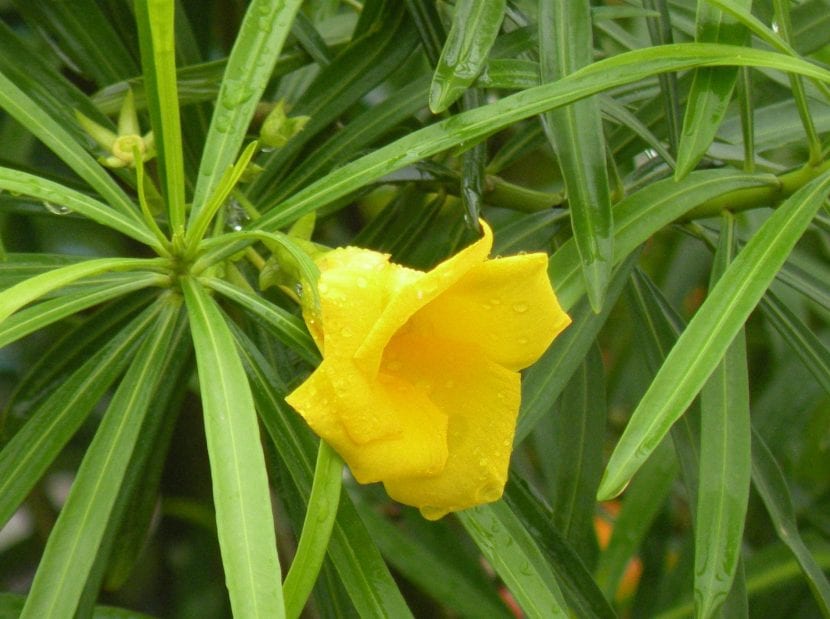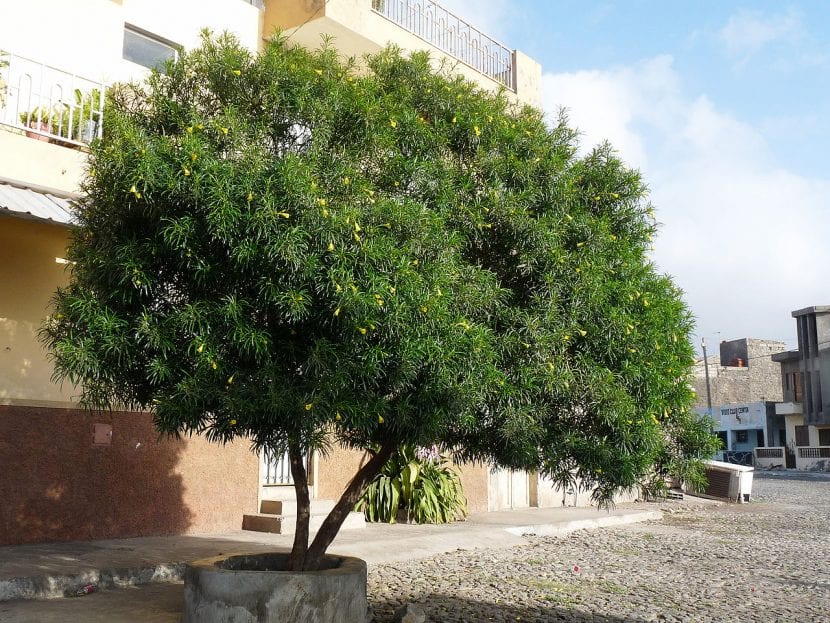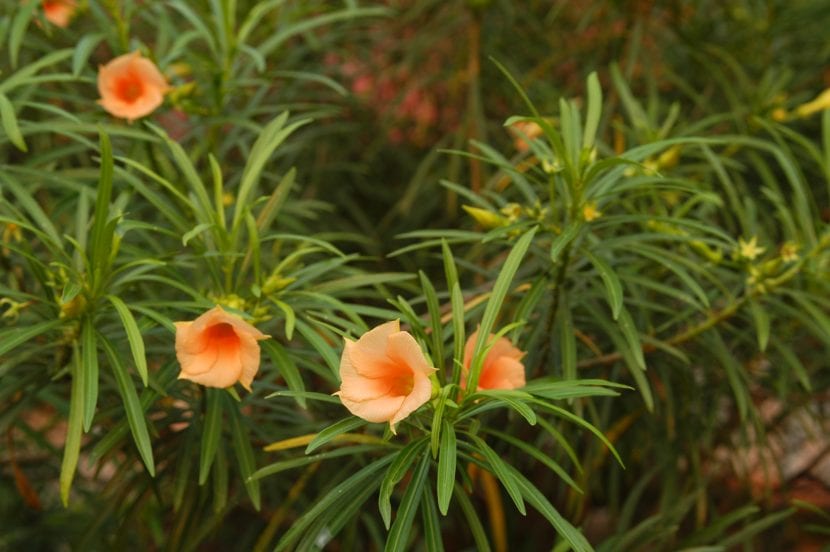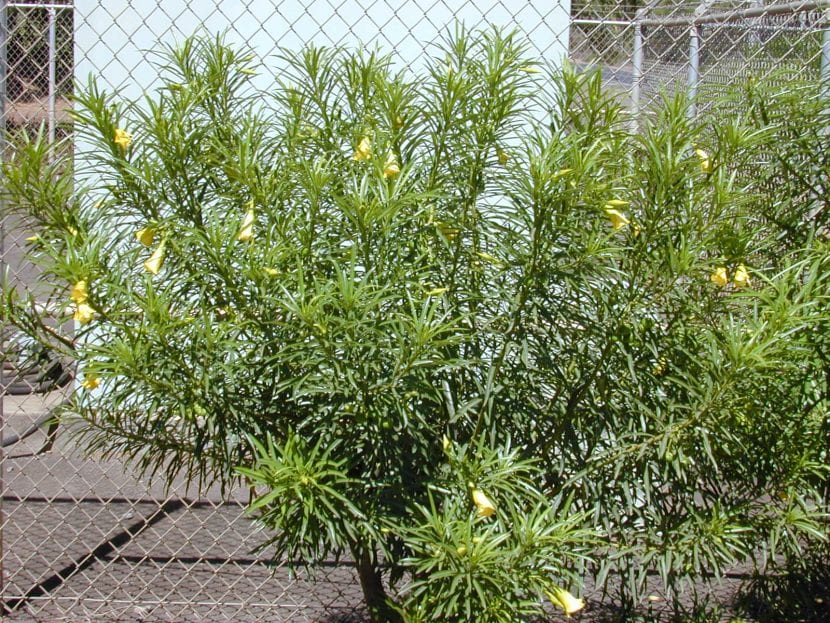
La Peruvian Thevetia it is a perfect shrub for warm and mild temperate climates, why? Because it is a plant that takes the shape of a tree and also produces beautiful flowers for much of the year, especially in summer.
As if that were not enough, it can be grown in a pot. So, What are you waiting to meet her?
Origin and characteristics

Our protagonist is an evergreen shrub or tree (sometimes tree) that reaches a height between 3 and 8 meters whose scientific name is Peruvian Thevetia. It is popularly known as the Ayoyote tree, Fraile's bone or elbow, yellow oleander, Indian walnut, San Ignacio bean or amancay. Its leaves are linear, lanceolate, bright green.
The flowers are yellow, orange or soft, which give off a very pleasant aroma. The fruit is a rounded fleshy rump with ribs, which, when ripe, change from green to black. This is potentially toxic, and can cause the death of the person.
What are their cares?

If you want to have a copy, we recommend that you provide it with the following care:
- Location: outside, in full sun.
- Earth:
- Pot: universal growing substrate mixed with 30% perlite.
- Garden: it is indifferent as long as it has good drainage.
- Irrigation: 2 or 3 times a week in summer and every 4-5 days the rest of the year.
- Subscriber: from early spring to late summer with ecological fertilizers once a month.
- Planting or transplanting time: in spring, when the risk of frost has passed. Change the pot every 2 years, following the steps indicated in this article.
- Pruning: you don't need it. Only dry, diseased or weak branches should be removed at the end of winter.
- Multiplication: by seeds in spring. Direct sowing in spring.
- Rusticity: it resists frosts down to -7ºC. It can live without problems in hot tropical, subtropical climates and also in the Mediterranean.

What did you think of Peruvian Thevetia?
I'm looking for info because I had a seed that I planted in a pot and it has sprouted!
Great, congratulations.
Treat it with a fungicide spray to prevent fungi from damaging it.
Regards!
I would be interested to know a little more about the fruit, which here says that it is potentially toxic. I'm just starting out in gardening. Thank you very much Greetings from Argentina.
Hello Sea.
What would you like to know?
The fruit is toxic, but only if it is consumed 🙂
Greetings.
Hello, continuing with the comment on the toxic fruit… .How bad for a house with animals… .if the fruit falls off… to ripen… is it still so toxic? Is it possible that dogs can try to eat it? Any comment is appreciated to help make a good decision ... and for the children ... if they touch it? ... nothing happens ?.
Hi Hernan.
The fruits are only toxic if eaten; just by touching them nothing happens.
Animals, dogs, cats, are very clever and tend to know well which plants they can and cannot eat, but just in case it doesn't hurt to avoid having toxic plants in the garden and orchard.
Greetings and happy new year.
Hello . I am María from Tucuman, Argentina. A query does this plant have a lot or little root? .. I want to plant small trees but I need to be with little root x space. Thanks
Hello Maria.
In general, all shrubby plants are low-rooted plants. In the case of the Thevetia peruviana, you will not have problems 🙂
regards
Hello, how are you? I saw that they sell the seeds of this plant as a musical instrument, called Chajchas, I read that it is toxic. They are sold for children, so if a baby sucks it, it can be lethal? The seeds are not black, they are light brown and I opened one and they are dry. I will appreciate your answer. Best regards.
Hello Milagros.
From what I understand, the seeds are dangerous to consume, but I recommend consulting a doctor to be on the safe side.
Regards!
Hello, I have this little tree, it is in its first flowering, and most of the flowers turned brown at the base before opening, I have it in a pot under an eaves, since I live in an area where there is frost, so very well cared for, but the flowers are not able to open
Hi Gilda.
Does direct sun shine on you at some point? I ask you because the ayoyote needs a lot of light (better direct sun) to be able to bloom well.
Anyway, you say it is its first bloom. It is normal that the first one is not as good as it should be. Surely for the next few times it produces better quality flowers 🙂
Even so, and to have all the fronts covered: do you have a plate placed under it? If so, remove any excess water each time you water. And do not forget to pay it in spring and summer with some liquid fertilizer, such as guano, following the instructions specified on the package.
Regards!
Regards!
Good ... a query planted this little tree on the sidewalk, with a height of two meters and one day a malicious one broke it in half. When I saw it I ran to try to graft it in a V and I put mud and a stocking with seals on it ... I took out all the procedures since it was very leafy and I left the central stem. I hope it recovers since it is green but partly black ... speaking of the part of the broken stem ... my query is the following if the graft does not work, can I make a new graft with another tree? Thanks for the info
Hello, I have a little tree and for the first time I am seeing that it gives a kind of little ball, I suppose that is its fruit and inside its seed. My question is, how could I get seeds out and be able to sow? How and when to sow it? Thanks.
Hi Anabel.
The ripe seeds of the Peruvian Thevetia they are brown and about a centimeter long. When the fruit matures, you just have to open it to extract them, and then clean them with water. Store them on a napkin until spring.
When the time comes, plant them, for example, in yogurt cups previously washed with water, filled with soil for plants. Drill a hole in the bottom so the water can drain out, and put a seed or two in each cup, buried just a little bit.
Finally, water and leave them in a sunny area. Go watering every time the soil dries up.
Greetings.